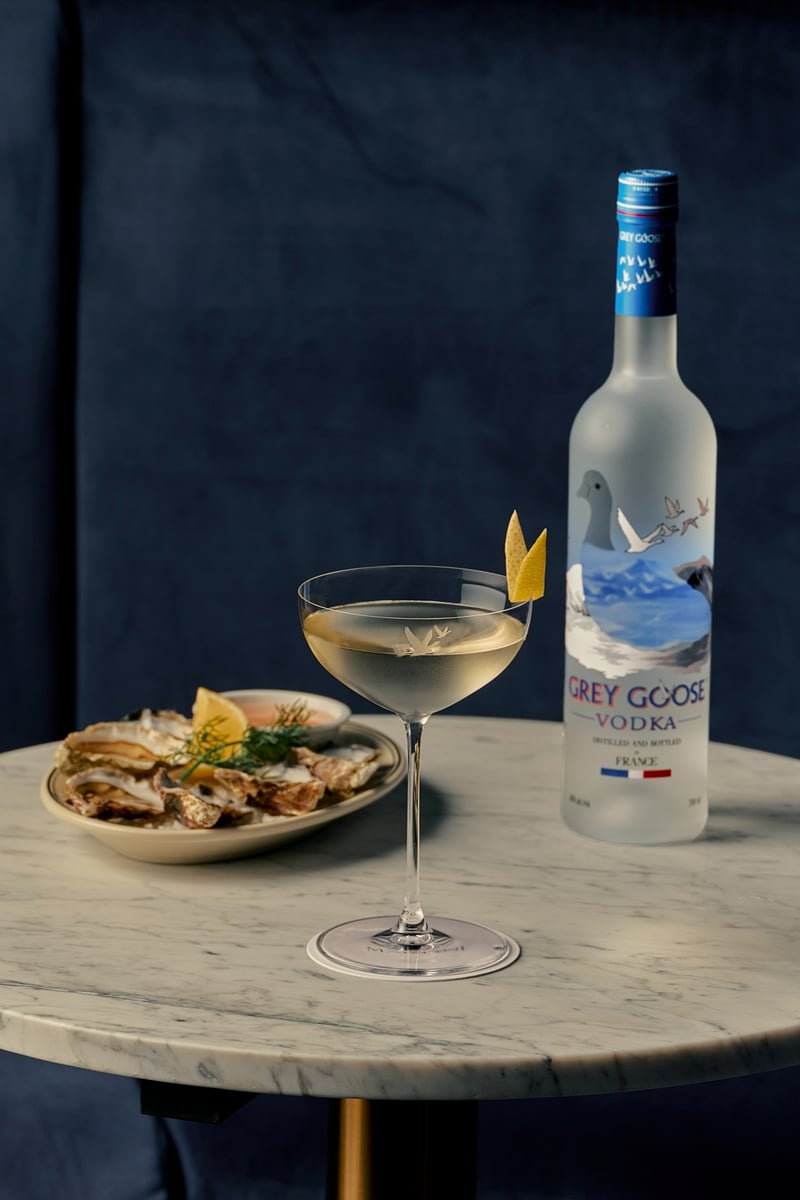Despite his titanic reputation in the drinks industry (once described by The New York Times as “one of the world’s foremost cocktail experts”) Dale DeGroff begins our interview in amusingly self-effacing fashion.
“You’ll have to excuse me if I forget a few names,” he says, eyes glinting from within the cavernous half-light of Apollonia. “My 75 years are catching up to me.”
With no apparent effort, the Elder Statesman of American craft cocktails – who is in town for the launch of the world’s first standalone GREY GOOSE bar, created in partnership with Crown Melbourne – then begins firing off some truly quotable anecdotes.
RELATED: Grey Goose’s Very First Standalone Martini Bar Is Coming To Melbourne

DeGroff recalls arriving in NYC in 1969, trading his youthful obsession with the theatre for a lifetime of freshly squeezed citrus and Boston shakers (“it took me 30 seconds after getting there to realise that life in New York takes place in the bars of New York,” he says). There is a digression about the Manhattan restauranteur behind The Rainbow Room, Mr. Joe Baum. And of course, there is lots of talk about the Martini — that most princely of classic cocktails.
Revered by legendary bartenders , ranging from Harry Craddock to Audrey Sanders, it too is a beverage that has held the attention of DeGroff for many decades: as you’re bound to see in our wide-ranging conversation with him below.
Randy Lai: Dale, thanks for making the time to chat with Boss Hunting. Let’s talk cocktails.
As a legendary barman and authority on the subject, can you explain the perennial appeal of the Martini? Despite ebbs and flows in popularity, it appears (to me at least) to be a style of beverage that has never really gone away…
Dale DeGroff: To answer your question, we have to travel back through history [proceeds to fire up Google Slides].
Take, for example, Jerry Thomas’ recipe for a ‘Gin Cocktail’ — published back in 1862. You’ve got a “wine glass” of gin (old-timey language for two ounces), dashes of gum syrup, Curacao, and Boker’s bitters. We’ve eschewed a lot of those ingredients today, but the basic format of the Martini is already there.
It’s a similar story a few decades later when Harry Johnson writes The Bartenders’ Manual (1888). Except now, bartenders are opting for half a wine glass of gin and half a wine glass of vermouth.

RL: Sounds to me like what you’re describing is basically a 50/50 Martini…
DDG: Bingo. And this ‘Fiddy Fiddy’ (or whatever drinkers choose to call it) persisted in popularity right through Prohibition.
It was only after the 1930s that the present 3:1 Martini began to take off in popularity. One theory for this new ratio (between spirit and vermouth respectively) was that as America was plunged into WWII — and subsequently, the Cold War — drinkers tended to require stronger cocktails.
RL: [Laughs] I can see the logic. To tamp down on our fear of nuclear annihilation.
DDG: The point of this little history lesson is to illustrate how, all along, the Martini has been deeply embedded in the American zeitgeist. Since the 1800s it has appeared in every strata of society.
It’s in fine men’s publications such as yours [gestures] and basically at every bar in America: from the lowliest stoop to the fanciest Manhattan ballroom. To be clear, I’m not saying they’re all great, but wherever they’re available, they’re accompanied by a certain sense of [long pause]…
RL: Occasion?
DDG: … ceremony. It’s almost like the Japanese chanoyu. And, as a bartender, it behooves you to go with that particular sense of ceremony.
I vividly remember when I first started working at the Hotel Bel-Air in Los Angeles, the Senior Bartender there told me, on day one, “This is how the owner [Joseph Drown] takes his Martini.”
Joe’s order involved a little ramekin, a four-ounce carafe, a coup glass; and instead of vermouth, he preferred a variety of Fino sherry called La Ina.
RL: Very nice. And the carafe (of gin or vodka, I assume) goes into the ramekin, filled with crushed ice?
DDG: Exactly. So that the boss could take care of his own drink as he saw fit. And that’s the thing about the Martini — individual preferences are so much at the heart of it. There’s a reason why H.L. Mencken described it as “the only American invention as perfect as the sonnet.”


RL: Versus other premium French-distilled vodkas, what special something do you think a bottle of Grey Goose brings to the task of making cocktails?
DDG: Firstly, it’s important to say that I’ve had a long history with Grey Goose — even longer than you’d think. Sidney Frank, the gentleman who created the brand, was a genius of marketing.
In 1996, he hit upon the idea to do a full-bore luxury vodka, and he asked himself, “Who are the best distillers in the world?” The French of course!
RL: Well, in the context of wine distillates that’s certainly true…
DDG: … but also in Vodka. Think about it.
You’ve got the grain and you’ve got the water — that’s it. And again, some of the best water in the world is right underneath Cognac: right through the region’s calcified limestone soil.
Between Cognac’s pristine water and excellent distillers, it made so much sense to establish Grey Goose there. So, Frank and his guys brought their skills to bear and ended up with what was considered to be a pretty intense vodka.
I vividly remember in the 1990s that the TTB [Tobacco Tax & Trade Bureau] declared all vodkas must be “colourless, odourless, and flavourless.” [both laughing]
RL: I’m assuming that this insane directive has since been removed?
DDG: Totally. Because the range of vodkas is now so interesting that you couldn’t even begin to describe them like that with a straight face.

RL: Gotcha. So it’s Grey Goose’s intensity of flavour that makes it such a great choice for home mixologists?
DDG: Yes. In fact, the way I like to think of it is that Grey Goose has the robust ‘character’ to stand up to those ingredients — say, vermouth, in a Martini — you’d usually put into premium cocktails.
RL: Now, for more of a reader-focused question. Assuming the typical 3:1 Martini is a bit too punchy for some drinkers, what’s one variation you’d be happy to recommend?
DDG: Well, what I would say is that — in order to keep the ‘heart’ of the Martini — you should use gin or vodka, some kind of fortified wine or bitter apéritif; and from there you can pretty much go anywhere you’d like.
RL: But what about ratios of ingredients?
DDG: We were talking about the 50:50 earlier and, again, that’s a really great starting point for less punchy Martini variations.
Actually, at [Le Martini], for one of the signature drinks we’re serving, I split my ratio of vermouth even further using 12.5g of the dry stuff and then 6g of blanc vermouth. As you can see, it’s all about playing with the recipe’s original aspects — finding what works for you.
RL: Finally, we can’t pass up the opportunity to learn from a literal master, so what’s some essential advice you’d dispense to people looking to lift their cocktail game at home?
DDG: There’s no substitute — and I can’t emphasise this enough — for cracking open a really good book. You know what I mean? Of course, it doesn’t necessarily have to be my book, The Craft of the Cocktail, but if you’re interested in the evolution of certain drinks, such as the Martini, I do cover that off.
In terms of a more technical answer: everything that goes into your preferred cocktail glass must be cold. That’s number one.
Secondly, there has to be dilution. You can’t simply take cold vodka and vermouth and pour them into a coup. Any distiller, whether they make whisky or rum, will tell you that the addition of water opens up spirits. So when you stir a Martini, you’re opening up all of the ingredients that are in it.
Hot food, hot plate. Cold drink, cold glass. Makes sense, no?

Discover Dale’s exclusive menu of Martinis, including the ‘Harry’s Original’, ‘Grey Goose Millenium Dry ‘, and ‘Martinié Speciale’ at Le Martini Crown Melbourne. Open Thursday – Sunday, 5pm until late.
To learn more, visit Crown Melbourne online here.
This article is presented in partnership with Grey Goose. Thank you for supporting the brands that support Boss Hunting.












